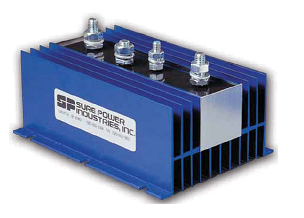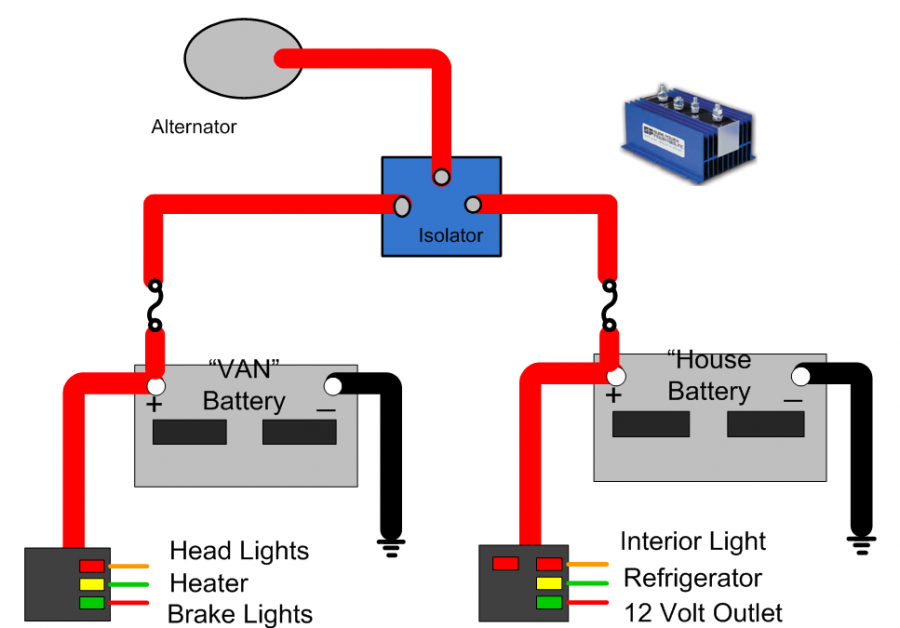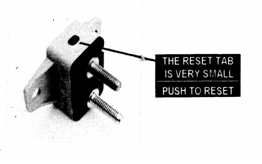 |
|
 01-17-2022, 06:08 PM
01-17-2022, 06:08 PM
|
#211
|
|
Senior Member
Join Date: Aug 2012
Location: Bend, Oregon
Posts: 491
|
I have a Blue Sea 7620 in my 2010 SMB. When you start the van there is typically a delay of maybe 20 seconds before you would hear the relay switch to charge house batteries. Now the delay seems to becoming longer over time. Do you guys think it is just because my start batteries are taking up a bit more charge before the Blue Sea switch to the house battery?
__________________
2010 E350 6.0 4x4 EB 50 SMB
|

|

|
 01-17-2022, 06:23 PM
01-17-2022, 06:23 PM
|
#212
|
|
Senior Member
Join Date: May 2007
Location: Beaverton, OR
Posts: 2,506
|
The specs for the 7620 are combines when voltage above 13.5 V for 30 secs, or above 13.0 V for 90 secs. So it could be possible that you are taking longer to get to the 13.5 voltage level.
-greg
|

|

|
 01-17-2022, 06:40 PM
01-17-2022, 06:40 PM
|
#213
|
|
Senior Member
Join Date: Aug 2012
Location: Bend, Oregon
Posts: 491
|
Thanks Greg, would the 90 second delay be due to the start batteries just having a lower voltage after the start? What would be your guess ? I also have dual alternators.
__________________
2010 E350 6.0 4x4 EB 50 SMB
|

|

|
 01-17-2022, 08:22 PM
01-17-2022, 08:22 PM
|
#214
|
|
Senior Member
Join Date: May 2007
Location: Beaverton, OR
Posts: 2,506
|
Yes, this could be an indication of some battery life, temperature, etc. Could also check to make sure the cable and lugs are tight from battery to 7620 isolator.
-greg
|

|

|
 01-18-2022, 07:47 AM
01-18-2022, 07:47 AM
|
#215
|
|
Senior Member
Join Date: Feb 2009
Location: PNW or maybe Baja Sur
Posts: 382
|
Bellpilot, you might take a voltmeter and monitor the voltages as you start....Even after initial monitor, disconnect the house batts to get some idea of the source....If you look at voltages at the different batts (and alternator outputs) at the same time you might find more about the source....
__________________
Pac NW and warmer places
1995 E250 EB 5.8 2WD on to a new owner
2006 E350 EB Elect Top 2WD
|

|

|
 01-18-2022, 07:43 PM
01-18-2022, 07:43 PM
|
#216
|
|
Member
Join Date: Apr 2008
Location: Tahoe City, CA
Posts: 40
|
The delay has nothing to do with the battery separator. It is a normal part of the 6.0 diesel system for the alternator to be delayed after start up. The alternator does not excite while the glow plugs are still energized. The signal to the alternator to start charging is the glow plugs shutting off. When the alternator kicks in is when you hear the battery separator connect. The delay time will vary and is affected by ambient temperature, engine temp, altitude, and such. The delay will typically be longer in colder temps.
__________________
Tim
2006 Ford E350 6.0 SMB 4x4 Modified EB45
|

|

|
 01-18-2022, 09:02 PM
01-18-2022, 09:02 PM
|
#217
|
|
Senior Member
Join Date: Aug 2012
Location: Bend, Oregon
Posts: 491
|
Thanks Tim and Morrefc!
__________________
2010 E350 6.0 4x4 EB 50 SMB
|

|

|
 05-01-2022, 09:24 PM
05-01-2022, 09:24 PM
|
#218
|
|
Member
Join Date: Mar 2022
Location: Boise
Posts: 48
|
Quote:
Originally Posted by Scalf77

Now we have it, a simple solution to separate my batteries when I want to, this is really the catís meow and still for a low cost. Well for the next couple of outings this solution works well. That is until the day I must have bumped the switch getting out of the van, because I am sure that I turned the switch off. So maybe there is a better solution out there and we just need to keep looking. Then one day browsing the latest JC Whitney catalog I see it. This new thing called an Isolator; actually SurePower invented the diode based isolator in 1959.

Now this must be the solution

Now the isolator is a grand solution, instead of using an old high power solenoid to combine the batteries, it is high tech and uses things called diodes. What does a Diode do? A diode only lets current flow in one direction, there are the electrical equivalent of a check valve. In the case of the isolator we let current go the direction from the alternator to battery, in this case both batteries, but the diodes prevent the current form going the other way, so we cannot get current from the Van Battery to power the House battery. No more switches, just install it and forget it. The isolator really did take care of some of the problems of using a Solenoid to connect and disconnect your batteries. One of the problems they liked to point out was when you switched the Solenoid on that current would flow from the charged battery to the discharged battery, thus if you switched the solenoid to connect before starting you would still; see some discharging of the van battery. Also, people were generally not using the proper gauge wire to handle large loads, so if your Van Battery went bad during the time you stopped and you turned on the solenoid and started the Van, all the cranking power would come from the house battery, that wiring may not handle that much current. All in all, it solved the one major problem and that was you didnít have to turn a switch, it would just work. Undersize wiring was bad in either case.
So if this utopia, why did we need something new? Well for a Diode to do it job, it needs to rob a little power to push through this door. It is called forward voltage drop. For most normal diodes made of silicon, it is about 0.7 volts. That means when the alternator is putting out 13.1 volts to your batteries you are really getting 12.4 volts to the battery. This of course was leading early battery life failure and loss of capacity in your system as you were never really getting your battery fully charged. So of course there had to be a better solution out there waiting for our use. |
I have recently aquired a 2001 7.3l SMB and have been working through it to figure out what is what. The house battery setup (dual 100ah AGM) is certainly lacking and i have been trying to figure out why. They really were struggling to keep up with the isotherm fridge after only 12 hours, even with solar charging during the day. So we went ahead and replaced those even though the receipt says they were only 2 years old. Initial results say that we did solve it but ill need to wait for anopther overnight trip to confirm.
next though, it would appear that part of the problem is that the house batteries are not charging while driving. I would expect the voltage on the magnum inverter to show they higher voltage if this was the case. So going down the rabbit hole here and trying to find what the problem is.
First i started with the SMB owners manual which did point me to the diode isolator under the coolant reservoir. Easy enough.

Its in the right location although a bit different orientation from the manual. Using a multi meter i was able to determine that the diode is functioning as expected across both banks.

Next step then is to check the circuit breaker. that is where i am getting lost. I found the part wrapped in electrical tape but i guess im not sure how best to test it. The part is listed as a Bussman CB124-50 24V G12 50A short stop circuit breaker. I ordered a new bluesea replacement part for it because it is cheap. Should i expect continuity across the circuit breaker to indicate it is indeed connected? currently getting nothing across the posts.
In summary my quesions are:
1. Should my inverter display show a charging voltage when the van is running like i see when the solar is charging?
2. Should the circuit breaker have continuity across it confirming that it is good (when removed from the vehicle)?
|

|

|
 05-02-2022, 04:35 AM
05-02-2022, 04:35 AM
|
#219
|
|
Senior Member
Join Date: Apr 2012
Location: Philadelphia, PA
Posts: 4,208
|
Battery Isolators,Separators, and Switches?
^^If your isolator is original from 2001 Iíd just proactively replace it. Itís on very borrowed time. They arenít too expensive and are easy to replace. You might want to upgrade at the same time. Plenty of threads with pros and cons of other units.
|

|

|
 05-02-2022, 06:02 AM
05-02-2022, 06:02 AM
|
#220
|
|
Senior Member
Join Date: May 2007
Location: Beaverton, OR
Posts: 2,506
|
If your inverter displays the house battery voltage, then yes you should see it change when charging from alt. The breaker should read continuity across it when out of the system. It could be auto reset or it may have a manual reset button.

As BrianW said is good time to put an upgrade on her wish list.
-greg
|

|

|
 |
|
 Posting Rules
Posting Rules
|
You may not post new threads
You may not post replies
You may not post attachments
You may not edit your posts
HTML code is Off
|
|
|
|
 » Recent Threads
» Recent Threads |
|
|
|
|
|
|
|
|
|
|
|
|
|
|
|
|
|
|
|
|
|
|
|
|
|
|
|
|
|
|
|
|
|